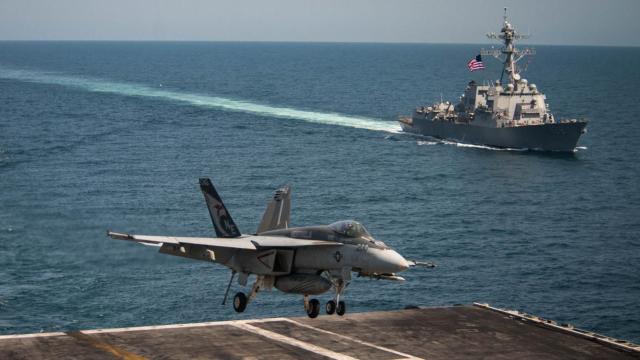The government of China has no comment on reports that it has built mock-ups of a U.S. aircraft carrier and missile destroyers in the deserts of Xinjiang region, according to the Guardian.
Satellite photos from Colorado-based Maxar Technologies show the outlines of one fake aircraft carrier and two fake Arleigh Burke-class missile destroyers near a six-metre-wide railway that could be used to simulate their movement in Ruoqiang county in the Taklamakan desert. U.S. Naval Institute News, citing intelligence company All Source Analysis, reported that the mockups appear to be part of a target range and are near another facility the Chinese military used to test DF-21D anti-ship ballistic missiles. (That missile is designed to take out vessels up to the size of an aircraft carrier in a single devastating blow.) Wang Wenbin, a Chinese foreign ministry spokesperson, told reporters he didn’t know anything about the fake vessels.
China builds mockups of U.S. Navy ships in area used for missile target practice https://t.co/agkyfNjFq4 pic.twitter.com/KQaq181fJi
— Reuters (@Reuters) November 8, 2021
Wang said during a regular briefing that “I’m not aware of the situation you mentioned,” according to the Guardian.
Reuters reported that in the latest annual Pentagon summary of Chinese military capacities, which focused in particular on tensions with U.S. forces over the South China Sea and the status of Taiwan, Defence Department analysts wrote that the People’s Liberation Army Rocket Force have conducted anti-ship missile tests in contested waters north of the Spratly Islands. Collin Koh, a research fellow at Singapore’s S. Rajaratnam School of International Studies, told Reuters that the tests may have demonstrated the need for more refinement to the DF-21 missile program that would need to be conducted away from foreign observation, or where the live-fire exercises could be held without triggering complaints from other nations like Japan.
“The best way to test it and keep it out of the prying eyes of the U.S. military and intelligence assets is to do it inland,” Koh told Reuters.
USNI News wrote that there are clear signs of a “sophisticated instrumented target range” at the site of the fake vessels. The mocked-up carrier lacks details such as an island (control tower) or weapon sponsons, but does appear similarly on radar as a real carrier would, according to USNI News. Other targets are more sophisticated and include a 75 metre-long target running on the aforementioned rail network, as well as targets with upright poles that could contain instrumentation or be used to simulate the superstructure of a vessel during radar tests.
In addition to the DF-26 missiles, the Chinese military is developing massive anti-ship ballistic missiles that could be launched from strategic bombers, USNI reported. The AllSource Analysis report cited by USNI did not find evidence that the mockups at the Xinjuang range have been targeted in live-fire tests yet, but noted they are far more elaborate than a previous concrete mockup at the Shuangchengzi missile test range in the Gobi Desert in Inner Mongolia, which has been repaired numerous times after taking heavy fire.
“The mockups of several probable U.S. warships, along with other warships (mounted on rails and mobile), could simulate targets related to seeking/target acquisition testing,” AllSource analysts wrote in the cited report. “This, and the extensive detail of the mockups, including the placement of multiple sensors on and around the vessel targets, it is probable that this area is intended for multiple uses over time.”
Whereas China views Taiwan as a rogue province that will eventually be brought to heel, the U.S. has a policy of deliberate ambiguity in which it does not recognise Taiwan as a sovereign country but acts as a close political and military ally. Taiwan’s status, as well as the military balance of power in the strategically important and internationally disputed China Sea, are historically the biggest political flashpoints in U.S.–China relations. The U.S. continues to enjoy overall military superiority, but unlike China, its forces and interests are split across the globe. Meanwhile, China’s forces are nothing to scoff at and are rapidly becoming more technologically advanced, as evidenced by reports of a recent hypersonic missile test that apparently took U.S. military intelligence by surprise.
In the recent Pentagon report, according to the Guardian, U.S. officials warned that the People’s Liberation Army is attempting to reach nuclear parity with U.S. forces by the mid-21st century, and is deploying record numbers of naval and coast guard vessels to the South China Sea. Analysts wrote that the Chinese military’s “evolving capabilities and concepts continue to strengthen China’s ability to ‘fight and win wars’ against a ‘strong enemy’– a likely euphemism for the United States.”
